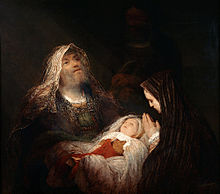Mit Fried und Freud ich fahr dahin, BWV 125
| Mit Fried und Freud ich fahr dahin | |
|---|---|
| BWV 125 | |
| Chorale cantata by J. S. Bach | |

Simeon's Song of Praise by Aert de Gelder, around 1700–1710
|
|
| Occasion | Purification |
| Performed | 2 February 1725: Leipzig |
| Movements | 6 |
| Chorale | "Mit Fried und Freud ich fahr dahin" by Martin Luther |
| Vocal |
|
| Instrumental |
|
Mit Fried und Freud ich fahr dahin (With peace and joy I depart),BWV 125, is a cantata by Johann Sebastian Bach for use in a Lutheran service. He composed this chorale cantata in Leipzig in 1725 for the feast for the Purification of Mary which is celebrated on 2 February and is also known as Candlemas. The cantata is based on Martin Luther's 1524 hymn "Mit Fried und Freud ich fahr dahin", and forms part of Bach's chorale cantata cycle, written to provide Sundays and feast days of the liturgical year with cantatas based on a related Lutheran hymn.
The gospel for the feast day, the presentation of Jesus at the Temple, includes Simeon's canticle Nunc dimittis, which Luther paraphrased in his hymn, providing an unusually close relation of the hymn and the liturgical occasion. Bach had used single stanzas of the hymn in his early funeral cantata Gottes Zeit ist die allerbeste Zeit, BWV 106, and in cantatas of his first Leipzig cycle.
In the format of the chorale cantata cycle, an unknown librettist retained the first and the last of Luther's four stanzas, while he both paraphrased the second stanza for an aria and included its original text in a recitative. The librettist derived text for two more movements from Luther's third stanza. Bach structured the cantata in six movements, framing four movements for soloists by a chorale fantasia and a closing chorale. He scored the work for three vocal soloists, a four-part choir, and a Baroque ensemble consisting of horn, flauto traverso, oboe, oboe d'amore, strings and basso continuo. The opening chorus has been compared to the opening movement of Bach's St Matthew Passion. In the third movement, Bach sets the single lines from the hymn's second stanza differently from the commentary in the librettist's words, but unifies both elements by a continuous "motif of joy" in the accompaniment.
...
Wikipedia
